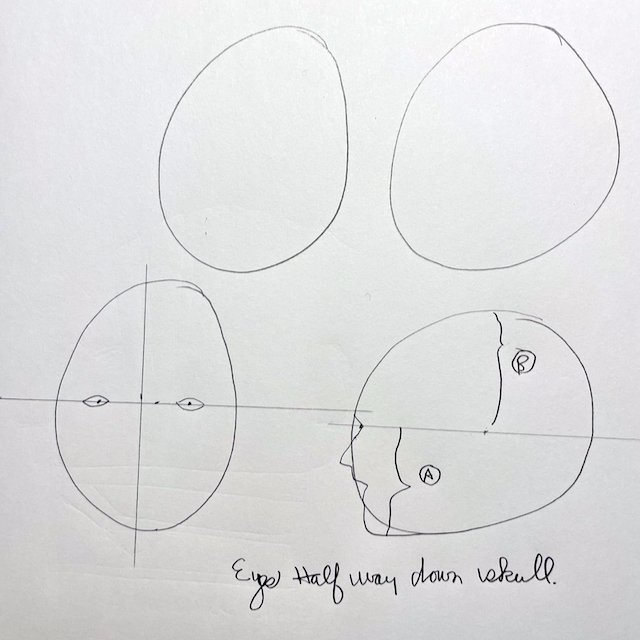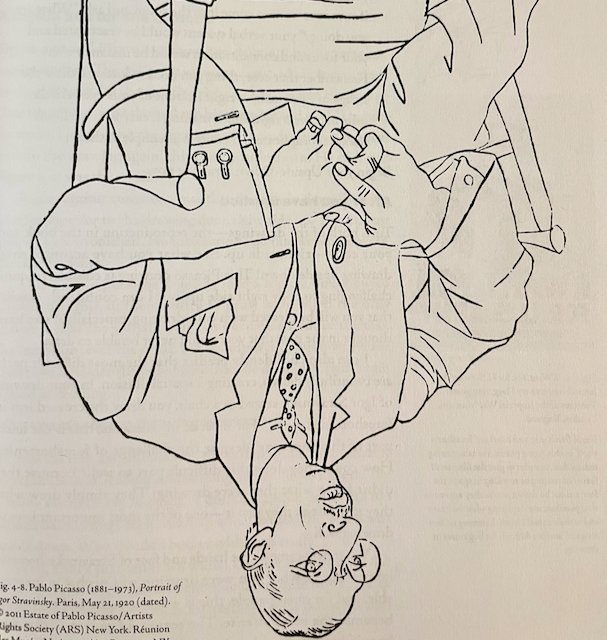Madame X
Today's drawing is day two of developing my portrait skills. Today was a warm-up exercise of drawing John Singer Sargent's Madam X. Focusing on the proportions and how the eyes, ears, and head proportions line up.
Putting aside what you see, people are even more alike than you think. There are infinite unique faces and features, but almost everyone is the same in many respects. For example, the eyes are halfway between the top of the skull and the chin, and the back of the eye to the back of the ear is the same distance as the front of the eye to the top of the head. In this crazy world, another example of what we have in common.
Learning the isosceles triangle of the head, eyes, and ears is fantastic. Progressing 1% a day.
Eyes Have It
After a break for health reasons, I am back working on and enjoying drawing. The next chapter of my Drawing on the Right Side of the Brain book course is portraits. The first section deals with proportions and precisely where the eyes fall o the skull.
Interestingly the eyes fall equidistant from the top of the head to the bottom of the chin. So even though our eyes (left brain) challenge this thought, it is accurate.
Today’s sketch is a basic shell with the axis and horizon drawn in on both the front and profile views of the head. I was getting comfortable with the placement of the eyes.
The Hand on the Picture Plane
Today’s assignment was to draw my hand in foreshortened view using a glass picture plane. This technique/learning tool was created back in the 1400s. This tool helps you see and draw a three-dimensional item on a two-dimensional plane.
It is unbelievably easy to trace my hand on the glass. It was interesting to me how the glass eliminated the stress and angst of trying to capture the depth of my hand. Instead, I focused on the lines and outside map of my hand and watch—a great learning experience.
I picked up a discount picture frame and a few cheap mats at the craft store—an inexpensive, practical glass picture plane.
Pure Contour Drawing - The Hand
Pure Contour Drawing – The Hand
An essential drill to help people develop their drawing skills was introduced in 1941 by Kimon Nicolaides; contour drawing. This drill helps build your skill in seeing the edges and contours of your subject.
In Drawing on the Right Side of the Brain, Betty Edwards modified the contour drawing into the pure contour drawing. Her drill has you looking at a subject, in this case, my left hand, and placing my other hand and pencil on the paper. I started the timer for five minutes and ONLY looked at my left hand. I followed the crevices and contours of my hand with my eyes and allowed my drawing hand to “follow” my eyes on the page.
Your outcome is a record of your perceptions of the creases in your palm, not a beautiful sketch of your hand.
Another Upside-Down Man
Today’s sketch was another where you look at the image upside down. This exercise from the book Drawing on the Right Side of Brain reduces mental conflict. Drawing upside down uses the gap between recognition (knowing you are drawing a man) and drawing upside down, so you focus on lines, angles, and circles. In other words, use the right side of your brain.
This Drawing is from page 53 of Drawing on the Right Side of Brain and is by Pablo Picasso of the Russian Composer Igor Stravinsky.
It was enjoyable, and I focused on the lines and angles, not calling out a head, face, or hands. It works.
Knoxville
We were dropping our son off at UTK this weekend. Today’s image was the morning view from the Hotel’s coffee shop window.
I was trying to get the signs, the trees, the buildings in the background, and the road. I have some work to do to get the road to fall into the background.
Good fun image to sketch.
Negative Space
Drawing the negative space around an object helps develop your vision and eye. In addition, there are details to observe about your subject and a whole set of elements of the area around your subject.
Try looking at the sky around the trees or buildings. What do you see? Have you ever noticed this before?
The Office Printer
Today I was working on straight lines and the depth of my subject and trying to get consistent lines to show the three dimensions of my printer.
This is harder than it looks. I’m generally happy with my progress, but something I will continue to work on.
The Pencil Sharpener
Today’s subject has nice lines and a bit of 3d to it. The pencil sharpener on my desk was filled a bit with shavings. I tried to show the transparent section. I’m also going to start including review notes. After I finish the sketch, I review it and note anything for future improvement.
I hope you enjoy it.
My morning coffee mug
I am starting to get consistent overall balance and perspective and don’t see the lean I did in my other drawings. I will try and capture review notes right on the drawing in the future. Not to be too critical but to provide learning points as I move forward.
Self Portrait
So I have some work to do on my realistic sketching skills. Interesting how this benchmark sketch, along with my hand and person from memory, indicates where my drawing skills currently are.
This self-portrait is a data point, not a criticism of where my skills are currently. I am only concerned with improving against myself, not comparing myself to others.
I’m the only one on my journey.
My Hand
The second baseline drawing and a good barometer of my progress is drawing my hand. I did an original hand drawing when I started this journey back on July 20th. I have progressed.
In everything you do, evaluating where you are to where you were is good. Celebrate your progress against yourself, not against unrealistic expectations or even against others.
Takeaway Coffee Cup
Today is a different take on the coffee cup – the takeaway coffee cup. My focus was on capturing the roughness of the sleeve and the overall shape. So why do my drawings lean to the right?
Any ideas or thoughts?
I’m enjoying the process and seeing improvements in my drawings over the past month.
The Bike
Interesting how difficult it is to describe or draw something from memory. We have seen thousands of bikes, but sketching a bike from memory is complex. Remembering all the essential details is hard. This is true for many things we try and do from memory.
Today’s sketch is a simple bike – from memory. I really had a hard time getting the details – how does the down tube look, do I have brakes, how about the derailleurs…. And I raced bikes.
Another good exercise in slowing down and working through the details, something we can all do; sketching or not.
Elements of Drawing – Yogurt Container
Today’s lesson was about breaking down sketching and observation into the ABCs. Break what you see into straight lines, curves, angles, circles, and dots. I put this concept to work on my morning breakfast, yogurt.
I hope you are enjoying my sketching skills journey.









